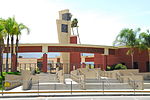The Corona Founders Monument is a monument built in 1936 to the founding fathers of the City of Corona in the Riverside County, California. The monument was designated a California Historic Landmark (No.738) on June 6, 1960. The monument is in the Corona City Park in the 100 block of 6th Street of Corona, California. The founding fathers at first called the city South Riverside after the company they started the South Riverside Land and Water Company.The founding fathers of the City of Corona on May 4, 1886, bought land from the Rancho La Sierra and the Rancho Temescal Mexican land grants. On this land the founding fathers planted orange trees and lemon trees. By 1912 Corona have 5,000 acres of lemon, orange, grapefruit, limes and tangerines groves. With the groves came packing and processing plants. In Corona about 80% of all job were in the citrus industry. The citrus industry continued in Corona into the 1980s. Corona had the title of Lemon Capital of the World, but lost it to Ventura County, California. Corona Heritage Park & Museum at 510 W Foothill Parkway, Corona, California had displays about the Corona citrus industry. On July 13, 1896, South Riverside incorporate and changed the city name to Corona. Corona is Spanish for “Crown”. H.C. Kellogg laid the city out in a one-mile diameter circle in 1887, with Grand Boulevard three miles around it. To the North of the circle was a railroad station and citrus packing houses. To the South acres of citrus groves of what was called "Queen Colony'.On May 4, 1886, for $110,000 they started the South Riverside Land and Water Company with the purchase of:
From Rancho La Sierra 11,5100 acres from the Yorba family.
From Rancho Temescal 5,000 acres from the Serrano family.Counting for inflation $110,000 in 1886 would be almost $3 million in 2018 dollars.






